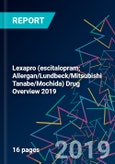Drug Overview
Lexapro (escitalopram; Allergan/Lundbeck/Mitsubishi Tanabe/Mochida) is a selective serotonin reuptake inhibitor, and acts by blocking the re-uptake of serotonin at the serotonin reuptake pump of the neuronal membrane, thereby enhancing the actions of serotonin on 5-HT1A autoreceptors. The active ingredient escitalopram is the S-enantiomer of citalopram, which also has a longstanding history of use for psychiatric indications. Both antidepressants were discovered by Lundbeck and have been co-marketed with Allergan in the US.
Lexapro was first approved by the US Food and Drug Administration (FDA) for the treatment of major depressive disorder (MDD) in August 2002. In March 2009, the FDA approved Lexapro for the acute and maintenance treatment of MDD in adolescents aged 12–17. Across the EU, Lexapro is marketed by Lundbeck as Cipralex, where it has been commercially available since 2002. The product is also available under a variety of different brand names within individual EU countries where Lundbeck has specific co-marketing agreements. The drug was launched under the Lexapro brand by Japanese partners Mitsubishi Tanabe and Mochida in August 2011.
Analyst Outlook
Lexapro (escitalopram; Allergan/Lundbeck/Mitsubishi Tanabe/Mochida) is widely perceived to be among the best antidepressants on the market, balancing robust efficacy with a good tolerability profile. This was supported by a clinical trial strategy that demonstrated superiority over a comparator, and also considerable marketing by Forest. The drug has reached and surpassed its commercial peak, with generic formulations almost entirely eroding its value in the major markets. Lexapro’s late introduction to the Japanese market by Mitsubishi Tanabe and Mochida will provide a small opportunity for growth, where the drug will have market exclusivity until 2019.
Lexapro (escitalopram; Allergan/Lundbeck/Mitsubishi Tanabe/Mochida) is a selective serotonin reuptake inhibitor, and acts by blocking the re-uptake of serotonin at the serotonin reuptake pump of the neuronal membrane, thereby enhancing the actions of serotonin on 5-HT1A autoreceptors. The active ingredient escitalopram is the S-enantiomer of citalopram, which also has a longstanding history of use for psychiatric indications. Both antidepressants were discovered by Lundbeck and have been co-marketed with Allergan in the US.
Lexapro was first approved by the US Food and Drug Administration (FDA) for the treatment of major depressive disorder (MDD) in August 2002. In March 2009, the FDA approved Lexapro for the acute and maintenance treatment of MDD in adolescents aged 12–17. Across the EU, Lexapro is marketed by Lundbeck as Cipralex, where it has been commercially available since 2002. The product is also available under a variety of different brand names within individual EU countries where Lundbeck has specific co-marketing agreements. The drug was launched under the Lexapro brand by Japanese partners Mitsubishi Tanabe and Mochida in August 2011.
Analyst Outlook
Lexapro (escitalopram; Allergan/Lundbeck/Mitsubishi Tanabe/Mochida) is widely perceived to be among the best antidepressants on the market, balancing robust efficacy with a good tolerability profile. This was supported by a clinical trial strategy that demonstrated superiority over a comparator, and also considerable marketing by Forest. The drug has reached and surpassed its commercial peak, with generic formulations almost entirely eroding its value in the major markets. Lexapro’s late introduction to the Japanese market by Mitsubishi Tanabe and Mochida will provide a small opportunity for growth, where the drug will have market exclusivity until 2019.
Table of Contents
OVERVIEW- Drug Overview
- Product Profiles
- Lexapro: Depression
LIST OF FIGURES
Figure 1: The author's drug assessment summary of Lexapro for depression
Figure 2: The author's drug assessment summary of Lexapro for depression
Figure 3: Lexapro sales for depression across the US, Japan, and five major EU markets, by country, 2017–26
LIST OF TABLES
Table 1: Lexapro drug profile
Table 2: Approval history of Lexapro for depression in the US, Japan, and five major EU markets
Table 3: Late-phase trials of Lexapro for depression
Table 4: Lexapro for depression – SWOT analysis








